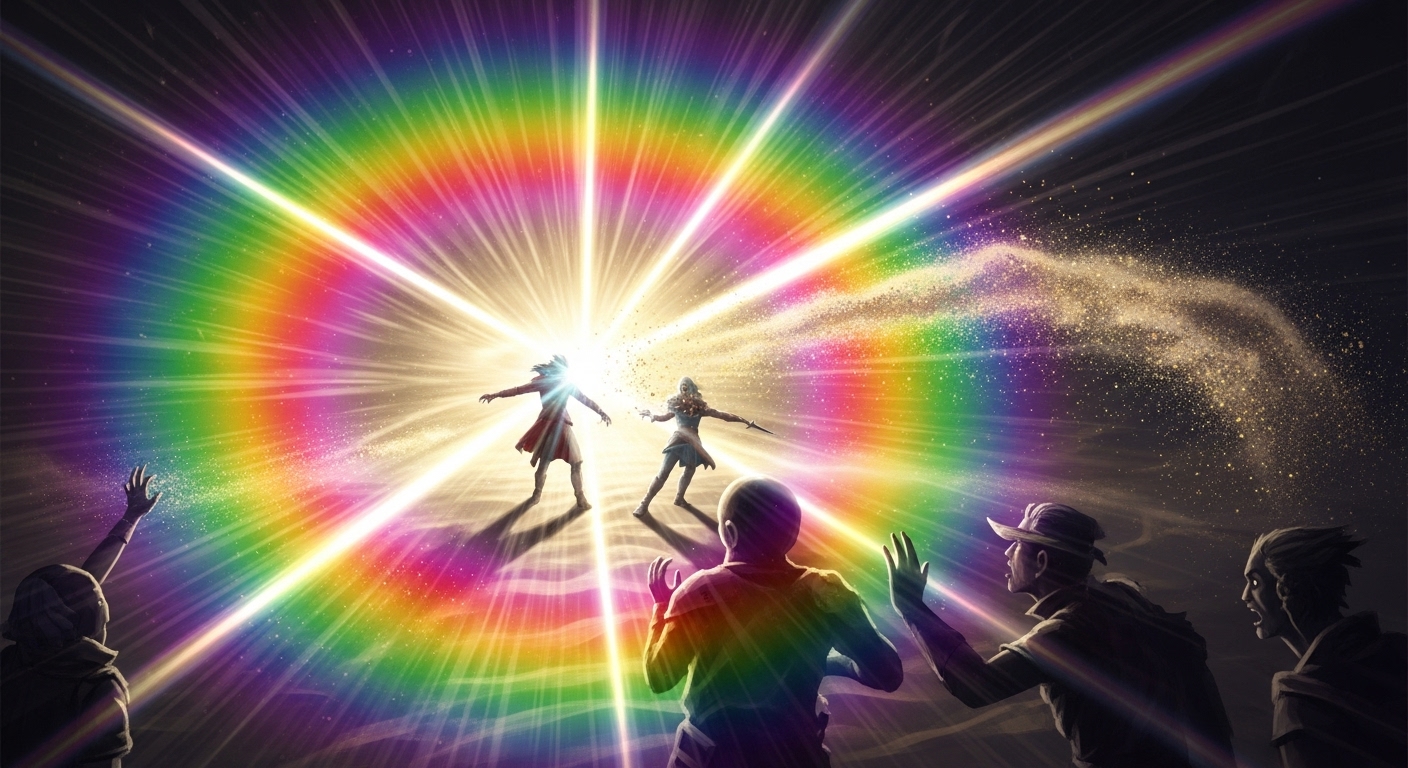Color Spray

- Level: 1
- School: Illusion
- Class: Bard, Sorcerer, Wizard
- Casting Time: Action
- Range: Self
- Components: V, S, M (a pinch of colorful sand)
- Duration: Instantaneous
You launch a dazzling array of flashing, colorful light. Each creature in a 15-foot cone originating from you must succeed on a Constitution saving throw or have the Blinded condition until the end of your next turn.
Tactical Usage
Crowd Control: Color Spray provides reliable area blindness that affects multiple enemies in close formation. This 1st-level illusion spell excels at disabling groups of weaker opponents and creating tactical advantages.
Optimal Timing: Most effective against clustered enemies early in combat before they can spread out. The short duration requires immediate follow-up to capitalize on the blindness.
Resource Management: Uses a 1st-level spell slot - accessible to low-level casters. Simple components make this readily available for repeated use.
Target Selection: Position yourself to catch the maximum number of enemies in the 15-foot cone while avoiding allies.
Spell Combinations
Synergistic Spells:
- Misty Step/Cunning Action: Use blindness to break line of sight for escape
- Hold Person/Sleep: Follow up on blinded enemies with save-or-lose effects
- Sneak Attack: Allies gain advantage against blinded targets
Class Feature Interactions:
- Metamagic (Heightened): Force failed saves on priority targets
- Channel Divinity: Combine with cleric abilities for enhanced battlefield control
- Bardic Inspiration: Coordinate with allies to maximize advantage from blinded enemies
Multi-Caster Coordination: Multiple color sprays can blind different enemy groups, creating widespread battlefield disruption.
Material Component Details
Component Acquisition: Pinch of colorful sand - easily obtained from beaches, deserts, or purchased from component suppliers.
Component Handling: Minimal cost and weight make this component easy to maintain in adequate quantities.
Roleplay Opportunities: Collecting distinctive colored sands from different locations can create character background elements.
Economic Considerations: Negligible cost makes this spell economically viable for frequent use without budget concerns.
Creator Notes
Encounter Balancing: Affects multiple enemies but only briefly. Consider how blindness impacts encounter tactics and enemy positioning.
NPC Usage: Enemy spellcasters can use this to escape or set up more dangerous follow-up attacks against blinded party members.
Environmental Considerations: Bright lighting conditions might reduce the spell's effectiveness thematically, though no mechanical penalties apply.
Campaign Integration: Useful for non-lethal crowd control in social situations or when subduing rather than killing is preferred.
Environmental Interactions
Terrain Effects: Indoor areas with narrow spaces maximize the cone's coverage. Open areas allow more enemy spreading to avoid the effect.
Weather Influence: Bright sunlight or complete darkness might thematically affect the spell's visual impact, though mechanics remain unchanged.
Structural Interactions: The cone originates from you, so positioning relative to walls and obstacles affects targeting options.
Elemental Interactions: Areas of magical darkness might suppress the visual effect, though the spell should still function mechanically.
Common Rulings & Clarifications
Timing Questions: Instantaneous duration for the spell itself, but blindness lasts until the end of your next turn for affected creatures.
Target Limitations: Affects creatures in the cone area regardless of size or type - no creature immunity unless specifically stated.
Duration Interactions: Blindness condition follows standard rules - grants advantage to attackers and disadvantage to the blinded creature's attacks.
Mechanical Interactions: Constitution saving throw targets physical resilience rather than mental resistance, making this effective against many creature types.
Alternative Applications
Non-Combat Uses: Create distractions during stealth operations, disable guards non-lethally, or provide cover for quick escapes.
Social Encounters: Subdue hostile crowds without permanent harm, though this typically escalates rather than resolves social conflicts.
Exploration Applications: Temporarily disable groups of aggressive wildlife, create openings to flee from dangerous encounters.
Utility Functions: Signal creation in emergencies, though the brief duration limits usefulness for sustained communication.
Related Spells
Same School: Other illusion spells like minor illusion (cantrip simple effects), blur (2nd level personal defense), hypnotic pattern (3rd level area incapacitation).
Similar Effects: sleep (1st level unconsciousness), hypnotic pattern (3rd level incapacitation), blindness/deafness (2nd level targeted blindness).
Progression Options: faerie fire (1st level reveals enemies), hypnotic pattern (3rd level enhanced crowd control), confusion (4th level chaos effects).
Complementary Magic: misty step (capitalize on broken line of sight), shield (protection while enemies are blinded), magic missile (auto-hit blinded targets).
Scaling Analysis
Level Progression: Excellent early-game crowd control that decreases in relative effectiveness as enemies gain higher hit points and saves.
Upcast Benefits: No direct scaling benefits make this primarily a 1st-level utility spell throughout the character's career.
Campaign Phases: Most valuable in early levels (1-5) when affecting multiple weak enemies provides significant tactical advantage.
Comparative Value: Competes with other 1st-level options but provides unique multi-target control that remains situationally useful.
Narrative Flavor
Casting Description: Brilliant rainbow light erupts from your gesture, creating a dazzling cascade of shifting colors that overwhelms the senses.
Effect Manifestation: Targets stagger and blink rapidly, hands instinctively covering their eyes as afterimages of swirling colors dance across their vision.
Personal Style: Illusionists might create geometric patterns, while bards produce musical light shows, and sorcerers manifest wild, chaotic bursts of color.
World Integration: Represents basic illusion magic that affects sensory perception, often associated with stage magic, carnival performers, or entry-level magical training.
50%